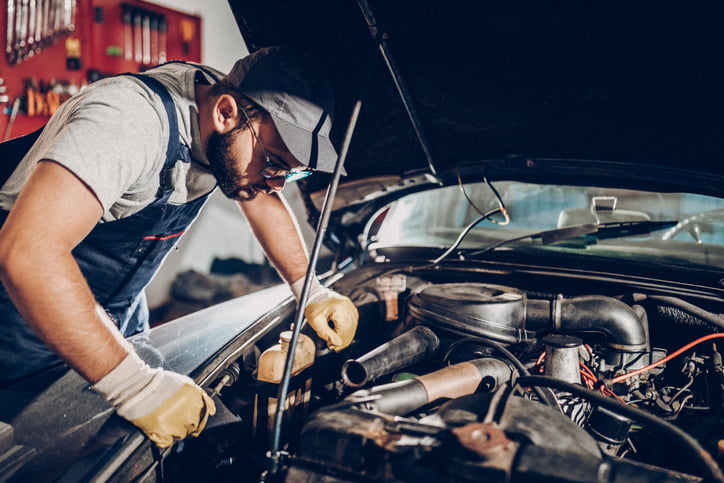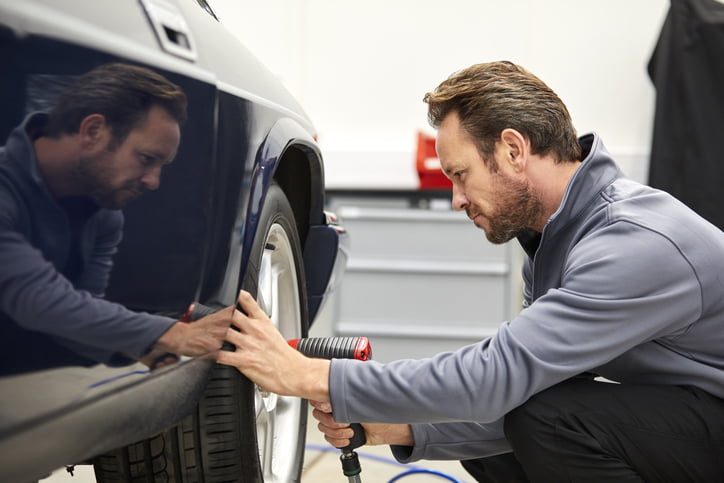Classic cars require a lot more care and attention than your average vehicle, and keeping your vintage motor in good condition takes time, effort and more than a little dedication. To give you a helping hand, we’ve compiled a number of hints and tips to help you maintain your classic car and keep it looking and performing at its best.
Use the links below to find the information you need.
- Check Your Fluids Regularly
- Take Good Care of Your Tyres
- Keep Your Classic Car Well Maintained
- Keep Your Car Clean
- Make Sure Your Classic Car Is Stored Correctly
Check Your Fluids Regularly

Things like oil, coolant and brake fluid are the lifeblood of your vehicle and failure to keep fluid levels regularly topped up could have catastrophic effects for your classic car. Here are some of the main things to look out for:
- Coolant – Check the level regularly and look out for any signs of contamination, such as a milky appearance or bits of particulate floating in the mixture. Maintain a 50/50 mix of distilled water and anti-freeze and perform a coolant flush once a year to prevent rust and corrosion.
- Oil – Check your oil every couple of weeks and before you take the car out for a spin. Make sure the oil is a nice amber colour and rub it between your fingers to ensure it’s free from any grit or dirt. Keep an eye out for any signs of a leak and aim to change the oil and filter at least once a year or every 1,000 miles.
- Brake fluid – Check the level and inspect the colour; it should be a light golden yellow; any darker and it may be contaminated. Brake fluid has a tendency to collect moisture, so to guard against brake failure, it’s good practice to flush out and replace your brake fluid at least once a year.
Take Good Care of Your Tyres

Often overlooked when it comes to classic car maintenance, tyres (particularly if they’re more than a couple of years old) need just as much TLC as the rest of your vehicle. Old or worn-out tyres can affect handling, grip, comfort and safety, and if you’re caught with illegal tyres, you’re looking at a hefty fine and up to 12 points on your licence. Here’s what you need to do to keep those tyres well-maintained:
- Check your tyre pressure at least once a month, and before and after every big trip. Driving your car with overinflated or underinflated tyres can lead to uneven tread wear and drastically reduce the lifespan of your tyres.
- When you make your tyre pressure checks, be sure to carry out a thorough visual inspection; check your tread depth and look for any obvious signs of damage, such as cuts, slashes, bulges and embedded glass or nails. If your tyres are more than five years old, pay particular attention to the sidewalls; small cracks in the rubber are a sure sign that your tyres need replacing.
- If your classic car is parked up for long periods, tyres can develop flat spots. To prevent this from happening, once or twice a month simply pop the car in neutral and roll it a couple of feet up and down the driveway.
- If it’s left longer than a month between drives, it’s best to remove the wheels altogether to prevent the tyres cracking and deforming under the weight of the vehicle. Store the tyres horizontally in a dry, moisture-free environment.
Keep Your Classic Car Well Maintained

On newer classics, you should expect to get around 100,000 miles between services, on older models, it’s probably closer to 50,000. To keep your vehicle in peak condition at all times, you need to get your hands dirty, get under the bonnet and perform regular checks yourself. Here are a few simple tips to help you keep your classic car firing as it should:
- Spark plugs: Old or worn out spark plugs can cause ignition problems, misfires, slow acceleration and loss of power. Check your spark plugs individually for signs of melting, wear or unusual deposits. Replacing faulty plugs can add tens of thousands of miles to the life of your engine.
- Battery: Even the smallest build-up of residue on the terminals can give you starting problems and drastically shorten the life of your battery. To remove excess grime, give the terminals a thorough cleaning with a baking soda and water mix and apply a little petroleum jelly to prevent any future corrosion.
- Belts and hoses: A faulty belt or a leaky hose can have serious repercussions for the overall health of your vehicle, leading to expensive repairs and even engine failure. To keep your belts and hoses in good working order aim to replace them every five years, listen out for unusual noises while driving and carry out regular visual inspections. Check hoses for any splits, leaks, bulges or signs of hardening and inspect your timing belt for any cracks, sheared teeth, undue wear or excess oil or grease.
- Regular use: One of the best (and most enjoyable) ways to keep your classic car in good working order is to take it out for a spin. A 30-minute drive a couple of times a month should be enough to blow off the cobwebs and flush out any dampness or condensation. Remember to start off slowly, particularly in cold weather, to give your car time to warm up and get the oil circulating.
Keep Your Car Clean

To protect your car from corrosion you need to keep it clean. Vintage motors are much more susceptible to the elements, and things like salt, grime and other impurities can cause lasting damage to your bodywork. For the best results, wash your car by hand at least once a month and ideally after every trip. Pay particular attention to the undercarriage and the wheel wells; these hard-to-reach areas are a breeding ground for rust and tend to pick up a lot of dirt and debris from the roadside. After your car has dried, apply a good quality wax. Not only will this give you a nice, glossy finish, it will also act as a sealant, preventing paint chips, reducing the appearance of scratches and protecting your bodywork from airborne contaminants. A lot of classic car owners prefer to store their vehicles during the colder months to protect them from the harsh conditions. If you plan to run your vintage motor all year round, you’ll have to take extra care to keep your car looking spick and span:
- In the autumn, falling leaves can become a major issue, getting into your air ducts and even finding their way into your engine compartment. To stop this from happening, avoid parking outside or invest in a good quality car cover with a soft inner lining that won’t mark your paintwork. This will also protect your car from other harmful contaminants, such as bird droppings, tree sap, rain and general dust and dirt.
- Damp weather, frost and salt from the roads can all speed up the formation of rust, so if you’re out and about during the winter months, it’s even more important to take care of your bodywork. Wash and wax your car after every trip, and apply an anti-corrosion spray to provide a little extra protection against the elements.
Make Sure Your Classic Car Is Stored Correctly

When you’re not using your classic car, particularly if it’s sitting idle for long periods, it’s crucial to store it in the correct environment. Here are a few tips to ensure your vehicle stays in the best possible shape while it’s under wraps:
- Park your car in a garage to protect it from the elements. Make sure the area is dry and well ventilated, as even a little moisture in the air can lead to corrosion. To create the ideal climate for your classic car, consider using a dehumidifier or if you have the space (and the money), an airflow tent.
- If you own a soft-top, always leave it with the hood up. If your top is down, moisture can accumulate in the folds, leading to mould and mildew, ruining the fabric.
If you’re storing your car for more than a couple of months:
- Remember to leave the handbrake off. Handbrakes have a tendency to seize up if your car is inactive for long periods of time. A set of wooden chocks will stop your car from rolling away.
- Lift the wipers away from the windscreen. If you leave windscreen wipers in place, there’s a good chance they’ll stick to the glass, destroying the rubber and rendering them useless.
- Disconnect the battery. To stop your battery going flat, disconnect it and hook it up to a trickle charger; this will monitor your battery while it’s not in use, providing an intermittent charge to offset any power loss.
- Add a stabilising product to your fuel tank. Over time, ethanol in petrol can attract water, causing the fuel to separate. This can lead to a build-up of corrosion and debris in your fuel lines and cause lasting damage to the engine. A good-quality fuel stabiliser will keep your fuel clean and protect your engine.
For more fuel advice and car maintenance guides, be sure to check out the rest of the Redex blog right here. Or, for our full collection of petrol and diesel fuel additives, visit our homepage today.
